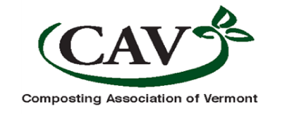How can I know that the compost I buy is okay to use?
Compost has been in the news, and not all the press is good. There are concerns about invasive worms, PFAS, and other potential contaminants. You might find yourself wondering: How can I know that the compost I buy is okay? A wise consumer knows what to look for and what questions to ask. We'll arm you with information based on science and outline all the benefits we collectively share when we keep food scraps out of landfills and in compost systems - and use compost in our gardens and yards.
Learn more about your concerns & understand what questions to ask to ensure you're buying compost you can feel good about using.
Plastic in compost…?
Have you ever tossed a banana or orange peel into a compost bin without removing the grocery store's small sticker used to identify the fruit type? It may seem like one little sticker isn’t a problem, but imagine the cumulative effect of millions of little stickers ending up in compost piles every day. And that’s just the tip of the iceberg!
The biggest challenge faced by composters worldwide is how to remove all of the things people put in their compost that aren’t supposed to be there. PLU stickers, those little identifiers found on fruit and vegetables, are the most common. The types and amounts of materials that are dropped off for composting, along with food waste, yard waste, and other organics inputs, are widely varied. Other common items include plastic liner bags of all types, disposable cutlery and food service items, condiment packages, straws, beverage containers, dog toys, lawn toys, and food packaging of all kinds. None of these items improve compost and instead create a major headache for the composters trying to create a high-quality product out of otherwise natural materials (food waste, plant waste, manures, wood waste, etc.).
Contaminants in food scrap stream. Photo by Nora Goldstein https://www.biocycle.net/tackling-contamination-in-food-scraps-stream/
Composters employ different methods for removing unwanted items from their process. Ideally, unwanted items are identified and removed before they make it to the facility. If not, they are often removed using manual or mechanical means either when the material is dumped or somewhere along the composting process. Just as the organic components break down, any plastics in the mix also break down into smaller pieces along the way. Unlike their organic counterparts, smaller and smaller pieces of plastic don’t become soil, providing nutrients and ideal media for growing plants - they just get smaller.
We’ve heard a lot in the media recently about microplastics showing up everywhere we start looking - in the air we breathe, in our waterways, our soils, our foods, and in the bodies of humans and other animals. After nearly a century of widespread plastic use, our world has become a massive consumer (and disposer) of this ubiquitous manufactured material. Collectively, we produce about 400 million tons of plastic waste every year. North America consumes 21% of this output. Even in areas with the best waste capture systems, huge volumes of plastics escape into the environment every day.
While the science is still catching up, it’s clear that we’re better off when our air, water, food, and bodies are free of plastics. Compost is no different. Vermont is leading the way with some of the best research to better understand the scope and significance of microplastics in organics streams, particularly from depackaged food waste that goes to anaerobic digestion and food waste that goes to composting. A team of researchers at the University of Vermont has recently published a study outlining preferred methods for the extremely difficult task of identifying and quantifying microplastics in these streams. It is likely that Vermont regulators and researchers across the globe will use their methods to continue more research into what types of plastics are most common in composts and how problematic it is.
What can you do?
The best thing consumers can do to prevent plastics in compost and soils is to make sure they’re separating their food waste from non-foodwaste
in back yard piles, and
when sending materials to a compost facility.
Take the extra moment to empty the moldy sandwich out of the Ziploc bag, pull the rubber band off the broccoli stalks, and peel the PLU stickers off your mango peels.




